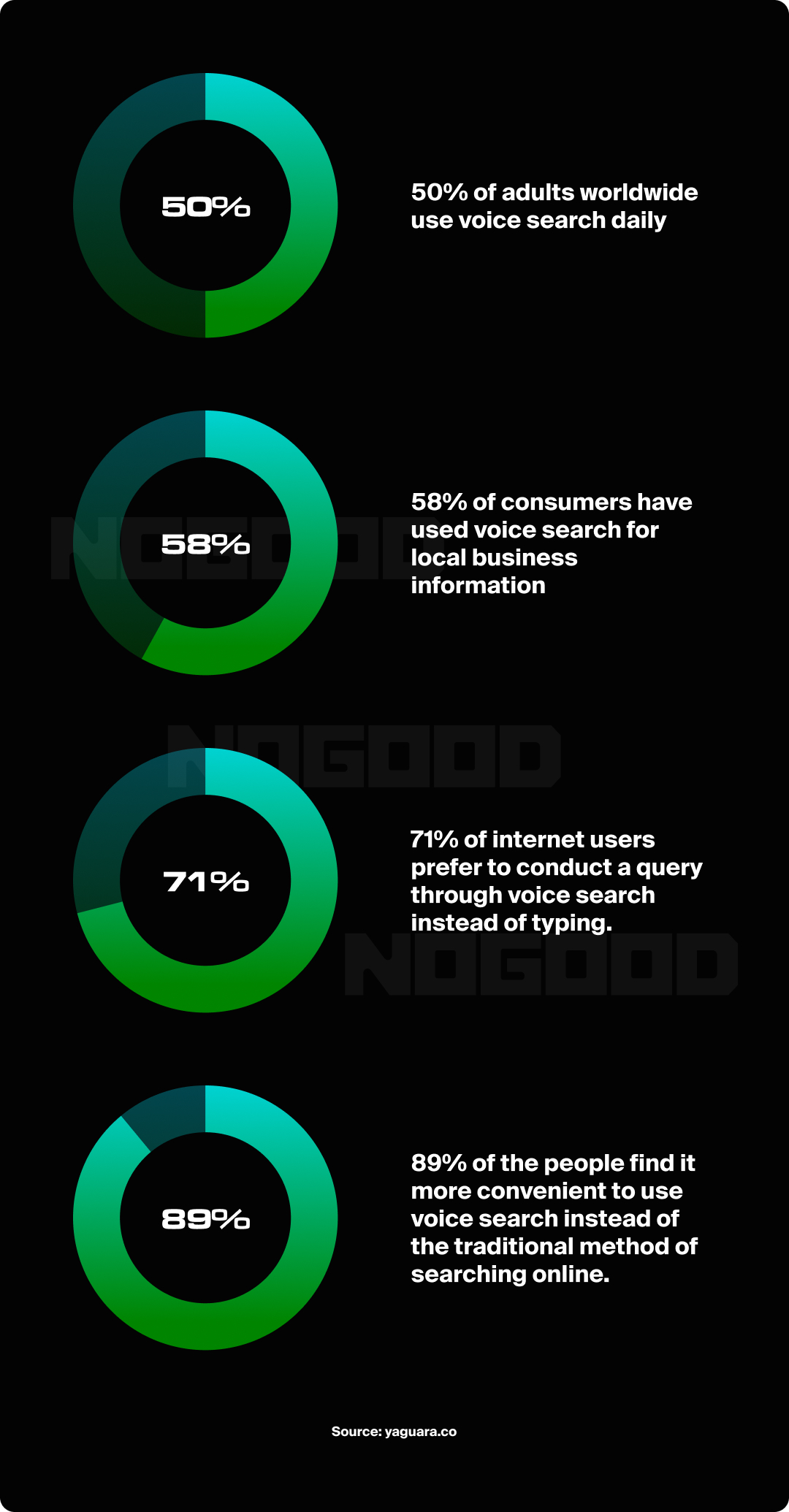For local businesses, optimizing for voice search is no longer a nice to have – it’s a necessity. With more users relying on voice assistants to deliver quick, informative answers, local businesses need to optimize their online presence to stay visible in these results.
Prepare your business for the future of voice search.
Why Local Businesses Need to Optimize for Voice Search

Voice search has fundamentally altered how consumers seek local information. Many users now rely on voice-activated devices to perform queries, often using phrases like “near me” or asking direct questions about local services. In fact, a significant portion of voice searches is dedicated to finding nearby businesses, with studies indicating that 58% of consumers have used voice search for local business information.
Unlike traditional text searches, which may yield multiple results, voice searches typically return a single answer, making it a winner-takes-all scenario that local businesses need to prepare for.
Being an early adopter of voice search optimization can provide a significant competitive advantage. As more consumers turn to voice search for convenience, businesses that proactively implement voice search strategies will not only improve their chances of being featured in search results but also create a better user experience. This forward-thinking approach can help businesses stand out and attract more customers before competitors catch up.
5 Steps to Optimize Your Local Business for Voice Search

Build Out a Google Business Profile
Optimizing your Google Business Profile is a game-changer for increasing local search visibility. Imagine a local restaurant that updates its profile with accurate hours, menu links, and inviting photos.
Not only does this boost their online presence, but it also drives more foot traffic through their doors. Keeping your profile up-to-date with real customer reviews & precise information ensures that when someone asks their voice assistant about a spot like yours, you’re the one that pops up.
To start, go to Google Business Profile and sign in with your Google account. You should use a dedicated business account rather than a personal one for better management and access control.
Input your business name accurately. Ensure it matches how it appears in the real world to avoid confusion. Choose a primary business category that best describes your services, as this helps Google understand what you offer.
If you have a physical location, enter the address where customers can visit you. If you offer services without a storefront, specify your service areas instead. This is crucial for local searches, as many voice queries include location-based terms like “near me.”
Optimize Your Profile with Customized Details:
- Business Hours: Clearly state when customers can reach you.
- Business Description: Write a concise description that includes relevant keywords related to your services.
- Photos: Upload high-quality images of your business, products, or services to engage potential customers visually.
- Attributes: Add specific attributes like “wheelchair accessible,” “free Wi-Fi,” or “Outdoor seating” that can appeal to certain customer preferences
Customized details such as hours of operation, descriptions, and attributes help voice assistants match your business to user queries.
If users ask for “Italian restaurant near me with vegetarian options and outdoor seating,” the voice assistant will reference this information from your Google Business Profile.
Encourage Customer Reviews
Customer reviews are a significant ranking factor for Google Voice Search. Businesses with a higher quantity of positive reviews tend to rank better in local search results. This is because Google prioritizes businesses that demonstrate credibility and trustworthiness, which are often reflected in customer feedback.
A strong collection of high-quality reviews signals to search engines that a business is reputable, increasing its chances of being featured prominently when users perform voice searches for local services.
While the number of reviews is important, the quality of those reviews also significantly impacts visibility. Businesses with numerous five-star ratings not only attract more attention but also enhance their perceived authority in the eyes of search engines. Positive reviews can improve the likelihood of being selected as the top result for voice queries, especially since many users rely on voice assistants to provide them with quick answers about local options.
Voice search users often seek immediate and relevant information about local businesses. Customer reviews provide potential customers with insights into the experiences of others, helping them make informed decisions quickly. This user-generated content can enhance engagement and trust, encouraging more interactions with the business, such as phone calls or visits, which are often initiated through voice commands.
Voice assistants often read customer reviews to support their answers. For example, if the user is looking for local restaurants that allow dogs, the voice assistant may read Google reviews that mention pets.
Create FAQ Pages
Voice assistants commonly reference FAQ pages as they align with the need to provide quick, informative answers.
A well-organized FAQ page helps users and voice assistants find the information they need without navigating through multiple pages, making it more likely for your business to be featured in a voice search result if you have optimized FAQ pages.
To increase visibility in voice search results, implement schema markup on FAQ pages as it helps search engines better understand the content and context of the questions and answers provided. This structured data can enhance visibility in search results and improve the chances of appearing in voice search responses by signaling to Google that this content is relevant and authoritative.
Google often pulls answers from FAQ pages for featured snippets, which are the concise answers displayed at the top of search results. Since many voice searches rely on these snippets for quick responses, having well-structured FAQ content increases the chances of being selected as a source for voice queries. To optimize for snippets, businesses should ensure their answers are succinct (around 30-40 words) and directly address the question posed.
Voice searches tend to be longer and more conversational than typed queries. FAQ pages allow businesses to incorporate long-tail keywords and phrases that reflect how people naturally speak. For instance, instead of just targeting “pizza delivery,” an FAQ might address “How fast is pizza delivery in my area?” This approach not only caters to voice search patterns but also helps improve overall SEO by targeting relevant keywords.
Optimize for Google’s AI Overviews
If a Google AI Overview exists for a query, it will most likely be used as the response for a voice search result, making it essential for local businesses to snag a spot in these results.
The foundation of optimization for Google AI is high-quality content that provides genuine value. This means moving beyond basic keyword strategies to create comprehensive, informative, and engaging content that answers user questions.
Here’s a quick breakdown of the basics:
- Create high-quality content that directly answers users’ questions in concise easy to digest formats such as a short paragraph or bullet points.
- Use LLMs such as Gemini, Perplexity, Claude, and ChatGPT to find questions users are asking about your niche, then target those questions with an FAQ or header tag in a blog post.
- Implement schema markup to FAQ, product, and service pages .
- Optimize your website for mobile devices with a responsive design.
Want to learn more about how to optimize your content for AI Overviews?
Improve Website Speed and Mobile Friendliness
Google considers page speed to be a ranking factor. Faster websites tend to rank higher in search results, including voice search queries. This means that optimizing your site for speed can directly influence its visibility when users perform voice searches for local information or services.
A mobile-friendly website adapts seamlessly to different screen sizes, which is crucial as many voice searches occur on mobile devices. Google prioritizes mobile-friendly sites in its rankings, making it essential for businesses to implement responsive design principles.
Key Ways to Improve Website Speed on Mobile:
- Remove excessive popups, CSS, and Javascript.
- Add responsive design elements to all pages.
- Make your navigation and menus seamless by reducing the number of clicks it takes to reach any given page on your website – for example, to view your menu or services, users should only have to click once or twice.
- Ensure all fonts are legible and big enough for users to see them easily.
- Position the most important information like business description, contact info, and services directly on your homepage for easy access.
- Optimize your image file sizes using a WordPress plugin or manually through resizing and changing the file types.
Voice Search Optimization is Essential for Local Businesses
As voice-activated devices become increasingly integrated into consumers’ daily lives, businesses must adapt their strategies to meet the evolving search behaviors of their customers. By optimizing for voice search, you’re not just following a trend — you’re setting your business up for success in an ai-driven future.




